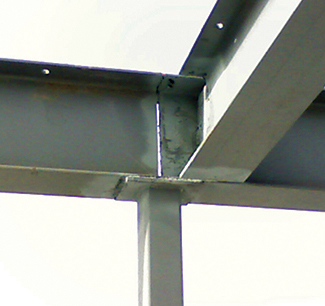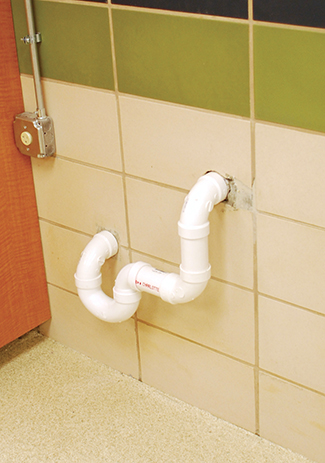
Are You Getting the Building You Expect?
By Rick Bacon, AIA
What the design team does during Construction Observation is probably not well understood. Know what you are facing if you elect to fly solo during the construction phase.
Most people know that architects design buildings and that contractors build buildings. So after the design is done and the contractor is hired, you don’t need the architect any longer, right? Not true! What does the design team do during construction, and how does it affect you one way or another?

The column should be centered on the base plate/footing.
Your architect and engineers provide what is called Construction Observation (CO) while the project is being constructed by the general contractor. What the design team does during CO is probably not well understood. It is a process by which the design team reviews the contractor’s submittals, including products, materials, and equipment, reviews the Applications for Payment, and reviews construction activity to confirm that things are being constructed according to what was designed, permitted, and bid. CO is intended to help the client know he is getting the building he is expecting and paying for. The design team does not tell the contractor how to construct the building, install equipment, or keep a site safe. The general contractor is legally responsible for the “means and methods” of construction. CO provided by the design team is a check and balance for the construction process.
I have seen lot of things during construction—some good and some very bad. The very bad examples occur often on projects where the client has tried to save money by eliminating the check and balance provided by construction observation services. The following are some examples of unacceptable work. One was a serious problem, and the others were less so.
He huffed and he puffed and it all fell down.
(Not really, but it could have.)
We designed a veterinary hospital for a sole practitioner moving from a rented tenant space into her dream hospital. The project is located in a hurricane-prone area. After the design was completed, and in an effort to save money, the client told us that only minimal construction observation on the project would be necessary. We agreed that we would provide some shop drawing review and that the contractor could call us with questions, etc. Regular site visits to observe the construction were not included.

The horizontal beam should be continuous and not “spliced.” The perpendicular beam should rest squarely over the support column underneath.
We started to get concerned when we hadn’t heard from the contractor for a while and he did not respond to our phone calls. We took it upon ourselves to make a visit to the construction site. Some of the steel erection construction we saw was shocking. Our client, a veterinarian running her own practice and trying to provide some construction oversight, would not be expected to know what to look for, so she didn’t know to say anything to the contractor.
The photos illustrating what we observed include the steel column (Photo 1), base plate, and beam connection (Photo 2). This was just one of the areas that were of significant concern for this building being constructed in a hurricane-prone area. As can be seen, the column is not centered on the base plate/footing. This means the load is now eccentrically loaded (off kilter). The next picture shows the beam not centered on the column and joint not located properly on the column. Another structural load concern is that the beam is supposed to be continuous without a joint or gap. The photo shows two non-connected beams or a spliced beam. The contractor was made to tear all of this down and install everything correctly. A potential and severe health and safety concern was averted.
We later found out that the original contractor went bankrupt and moved out of state with a large amount of our client’s money. Our client did hire a new contractor who did a good job completing the work. The hospital practice is thriving, and the story has a happy ending.
Would you have this in your home?
Every project seems to have some installation that is just not acceptable. Almost all areas of poor construction need to be corrected before the work is accepted by the architect, engineer, or the client.

The piping and electrical outlets should have been concealed within the wall.
I had a porcelain tile installation in the main lobby, which did not follow the tile pattern shown on the drawings. It was caught early enough not to be a problem. Then the tile installer says, “That’s the way we have always done it. Does it really matter in the end?” I can only ask, “Did you look at the drawings and bid it accordingly?” Slow response: “Well, yeah. I guess so.” My response: “Then why would you install it differently. Take it up and start again.”
Another example was the plumbing installation for a stacked washer and dryer. The plumber extended the drain line out of the wall (Photo 3). He realized it was in the wrong location. He connected more piping along the outside of the wall and extended the pipe back into the wall so it could be run to the correct location.
The problem was actually caused by the general contractor’s lack of coordination between the trades. They did not prepare correctly for the equipment’s installation. The piping (and the electrical outlets) should be concealed within the wall. I asked the plumber and project superintendent, “Would you accept that in your own home?” They, of course, shook their heads, and that’s all that was necessary to say.
You pay for quality work, so the construction should be done correctly. If not, it really should be removed and done again. If you ask the question, “Would you want this in your own home?” they get the idea and are likely to replace the work. If they say “yes,” then maybe you need to change contractors.
Most of the contractors and subcontractors I have worked with are good, but you still have to be vigilant about construction quality. Small projects can have just as many problems as large, multimillion-dollar projects. The general contractor, and especially the subcontractor, has a vested interest to get the job done quickly and move on to the next one. Don’t count on so-so work being redone unless you insist upon it. A large construction mistake may not be obvious until months after a project is completed. Even if your design team is providing a full complement of Construction Observation services, it does not mean you will not experience problems. Spreading the responsibility around benefits you and keeps these project checks and balances in tact.
I urge those of you who may be planning a sizable construction project to think seriously through your decision to include or not include Construction Observation services from your design team. If you have a bank loan, you may be required to have Construction Observation services. Don’t go it alone unless you have a thorough understanding of how a building is supposed to be constructed, can read and understand a set of construction drawings, are comfortable telling others their work is not up to snuff, have the time to devote to this important task, and are willing to assume the risk. Otherwise, you could be biting off more than you can chew.
Richard S. Bacon, AIA, is owner and principal architect at Bacon Group, Inc., an architecture firm that specializes in the design of animal care facilities. With over 35 years’ experience, Rick is a registered architect, member of the American Institute of Architects, credentialed by the National Council of Architectural Registrations Boards, a LEED Accredited Professional in sustainable design, and a licensed General Contractor. He is a frequent workshop presenter on a variety of design topics for the boarding, veterinary, and animal humane care communities. He may be contacted by phone at 800-961-1967 or via email at [email protected].


